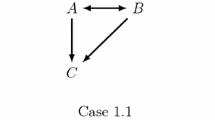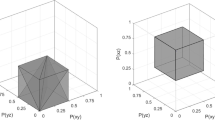Abstract
Decision theory is a theory of rationality, but the concept of rationality has several different dimensions. Making decision theory more realistic with respect to one dimension may well have the result of making it less realistic in another dimension. This paper illustrates this tension in the context of sequential choice. Trying to make decision theory more realistic by accommodating resoluteness and commitment brings the normative assessment dimension of rationality into conflict with the action-guiding dimension. In the case of resolute choice the conflict comes because of a clash of perspectives. The perspective from which resolute choice seems normatively compelling is not the perspective from which it can serve the purpose of guiding action.
Similar content being viewed by others
References
Bermudez J.L. (2009) Decision theory and rationality. Oxford University Press, Oxford
Boghossian P. (2002) How are objective epistemic reasons possible?. In: Bermudez J.L., Millar A. (eds) Reason and nature: Essays in the theory of rationality. Oxford University Press, Oxford, pp 15–48
Broome J. (2004) Weighing lives. Oxford University Press, Oxford
Dummett M. (1978) The justification of deduction. In: Dummett M. (eds) Truth and other enigmas. Duckworth, London
Gauthier D. (1986) Morals by agreement. Clarendon Press, Oxford
Hammond P.J. (1976) Changing tastes and coherent dynamic choice. The Review of Economic Studies 43(1): 159–173
Jeffrey R. (1974) Preference among preferences. The Journal of Philosophy 71(13): 377–391
Jeffrey R. (1983) The logic of decision. Chicago University Press, Chicago
Lewis D. (1983) Philosophical Papers Vol 1. Cambridge University Press, Cambridge
Machina M. (1989) Dynamic consistency and non-expected utility models of choice under uncertainty. Journal of Economic Literature 27: 1622–1668
McClennen E.F. (1990) Rationality and dynamic choice. Cambridge University Press, Cambridge
McClennen E.F. (1998) Rationality and rules. In: Danielson P.A. (eds) Modeling rationality, morality, and evolution. Oxford University Press, New York, pp 13–40
Pettit P. (2002) Rules, reasons, and norms. Oxford University Press, Oxford
Rabinowicz W. (1995) To have one’s cake and eat it: Sequential choice and expected utility violation. The Journal of Philosophy 92: 586–620
Raiffa H. (1968) Decision analysis: Introductory lectures on choices under uncertainty. Wesley-Addison, Reading, MA
Schick F. (1991) Understanding action: An essay on reasons. Cambridge University Press, Cambridge
Schick F. (1997) Making choices: Recasting decision theory. Cambridge University Press, Cambridge
Schick F. (2003) Ambiguity and logic. Cambridge University Press, Cambridge
Strotz R.H. (1956) Myopia and inconsistency in dynamic utility maximization. The Review of Economic Studies 23: 165–180
Wright C. (2002) On basic logical knowledge. In: Bermudez J.L., Millar A. (eds) Reason and nature: Essays in the theory of rationality. Oxford University Press, Oxford, pp 49–84
Author information
Authors and Affiliations
Corresponding author
Rights and permissions
About this article
Cite this article
Bermúdez, J.L. Pitfalls for realistic decision theory: an illustration from sequential choice. Synthese 176, 23–40 (2010). https://doi.org/10.1007/s11229-009-9482-3
Received:
Accepted:
Published:
Issue Date:
DOI: https://doi.org/10.1007/s11229-009-9482-3




